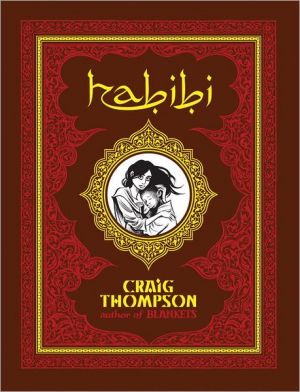- Comics
- Comics Reviews
- Manga
- Comics Reviews
- European Comics
- News
- Comics News
- Press Releases
- Columns
- Spotlight
- Digital Comics
- Webcomics
- Cult Favorite
- Back Issues
- Webcomics
- Movies
- Toys
- Store
- More
- About
By Leroy Douresseaux
October 2, 2011 - 14:40
 |
| Habibi cover image |
Habibi is the new graphic novel from cartoonist Craig Thompson (Blankets), and what a graphic novel it is. At almost 700 pages in length, Habibi (apparently Arabic for “my beloved”) is a massive tome containing a blockbuster of a comic. It is a sprawling epic that spans time while being surprisingly contemporary in places. It addresses the modern world, but is timeless and is steeped in past times.
At alternate places in the narrative, Habibi is set deep in Arabic deserts, right in the middle of slums and mind-boggling squalor, inside lavish palaces and harems, and finally in modern industrial centers. Habibi is the story of two refugee child slaves that are bound to each other by chance, circumstance, and need, but mostly by love. There is the older one, Dodola, an Arabic girl sold as a child bride and later sold into slavery. The younger is Zam, a black child that Dodola rescues and takes as her own.
Dodola and Zam become like mother and child, but they are eventually ripped apart, when Dodola is kidnapped. She is taken to Wanatolia, where she enters the great estate of the Sultan. He is a fat, lustful man who is always looking for something new in pleasure and gratification. Past the Gates of Felicity, Dodola is carried into the Sultan’s harem, where she becomes his greatest turn-on and most aggravating lover.
Meanwhile, Zam goes on his own journey, one that involves magical desert snakes and drought. His journey takes him from the most depressing slums to a house of sly and conniving eunuchs. Dodola and Zam’s lives will always unfold together, even when they are apart, but will they ever be reunited for good?
Habibi is magical storytelling. Symbolic and metaphoric, Habibi is also a parable and a fairy tale. Craig Thompson does so much in this graphic novel, both literally and figuratively. Habibi tries to bridge the first and third worlds, and in that attempt, it addresses racism in such a bold and blunt way that this graphic novel could find a place on the African and Black interests bookshelves. Thompson also unveils the common heritage of Christianity and Islam share, which is Judaism, in a matter-of-fact way that readers will be either offended or shocked, or perhaps delightfully surprised. Thompson transforms passages from the Koran into exquisite and enchanting graphical storytelling, composed of words, pictures, and graphics that come together like a striking piece of music.
Habibi is certainly a remarkable feat, but it is so big that sometimes I found myself getting lost. It seems to be about everything, but is really a long and winding love story of which the reader must keep track over 600+ pages. Habibi shifts in time so much and offers so many dream sequences and side stories that it is easy to see where one might get lost in all that black ink.
Also, some of the story seems to shift from the Middle East to the American Midwest, which is odd. Still, I could see Habibi being the best comic book of the year simply because it is so ambitious. I look at this whirling dervish of a tale and see it as a book that attempts to capture or to depict the complexity of humanity itself. Habibi is magical in its narrative and beautiful in its breath. Craig Thompson has given those who love the comics medium a treasure.
A